
Azaleas: planting, growing, pruning and care
Contents
Azaleas, in a nutshell
- In April-May, their generous and vivid flowering declinate in various colours.
- Foliage is evergreen in Japanese Azaleas, deciduous, colourful and attractive in autumn in Chinese Azaleas.
- Delicious scent of deciduous azalea flowers does not go unnoticed.
- They prefer partial shade and acidic soil, and appreciate watering or naturally cool soils.
- They are compact or medium-sized bushes that find their place in any garden, from smallest to largest, and thrive in pots, on balconies and terraces
A word from our expert
Azaleas are heather-soil bushes, small or medium-sized, very useful to brighten and enliven slightly shaded areas of garden, balcony or terrace.
There are Azaleas to grow outdoors and indoor Azaleas. The Azalea japonica or Japanese azalea is a rounded, compact garden bush with evergreen foliage. L’Azalea mollis or Chinese azalea, deciduous and very cold-hardy, forms an upright bush with usually scented flowers. The indoor Azalea, often found at florists, resembles a Japanese azalea but does not withstand outdoor cold. It is grown in a cool room in winter, between 5 and 15°C. It is usually forced to produce flowers in winter, as it normally flowers around April–May.
Their flowering, very abundant and attractive in spring, is sometimes scented. There are white, pink, red, bluish, orange or yellow azaleas. Flower centre is often marked by a pretty patch of yellow, orange or brown on the upper petal. Some azalea flowers appear double, because their calyx is the same colour as the corolla. One therefore sees two corollas nested one within the other. English call them Hose-in-hose.
Related to rhododendrons, azaleas are easier to grow and place in garden thanks to their modest size. They thrive in partial shade in acidic, lime-free, well-drained soil. Japanese azaleas are best placed at front of border, edging or container, and deciduous azaleas suit middle or back of borders well, thanks to their elegant upright habit. Ensure soil remains relatively cool. Pruning of an azalea, optional, can be carried out after flowering.
Description and botany
Botanical data
- Latin name Azalea japonica or mollis (for producers and gardeners), Rhododendron (for botanists)
- Family Ericaceae
- Common name Azalea
- Flowering between March and May for most
- Height 0.5 to 2 metres
- Exposure part shade to shade
- Soil type acidic, like heather soil, free-draining and cool
- Hardiness approx. -10 to -25°C
Azaleas belong to large family Ericaceae, like the Heathers, Blueberries, Japanese andromedas, Strawberry trees and of course Rhododendrons. There are more than 50 wild species of Azalea, such as Rhododendron luteum, R. canescens and nearly 8,000 cultivated varieties developed worldwide.
Botanists sensibly place Azaleas in genus Rhododendron, as their genetic origins and organs are very close. Growers and gardeners, more pragmatic, prefer to call them Azalea. Azaleas are generally smaller, differently shaped, sometimes deciduous and often fragrant. Compared with Rhododendrons, Azaleas have foliage more often lanceolate, ending in a point. Their flowers usually have 5 to 7 stamens compared with 10 in Rhododendron. Finally, they are used differently in the garden.
Azaleas are grouped into subgenera within genus Rhododendron. Evergreen Azaleas mainly come from subgenus Tsutsusi and deciduous ones from subgenus Pentanthera.
- Chinese Azaleas or Azalea mollis: deciduous, they don warm autumn colours and their flowering often releases a delightful fragrance. Colours range from white through various shades of yellow, red and flaming orange. They are vigorous and very cold-hardy. Most originate from North American species, except Rhododendron luteum, the pontic Azalea found in the Caucasus between Turkey and Eastern Europe. Modern varieties mostly descend from Rhododendron luteum, japonicum, molle, viscosum, occidentale, atlanticum, calendulaceum, flammeum, periclymenoides and arborescens.
- Japanese Azaleas or Azalea japonica: evergreen, they form small, rounded, compact shrubs. There are pink, red, white and mauve to purplish Azaleas, but never yellow. Original species are exclusively Asian, mainly Japanese. Parents of garden-cultivated Azaleas are generally Rhododendron kiusianum, kaempferi or yedoense. Indoor Azaleas, or florist’s Azaleas, derive from subtropical species such as Rhododendron simsii, indicum and mucronatum.
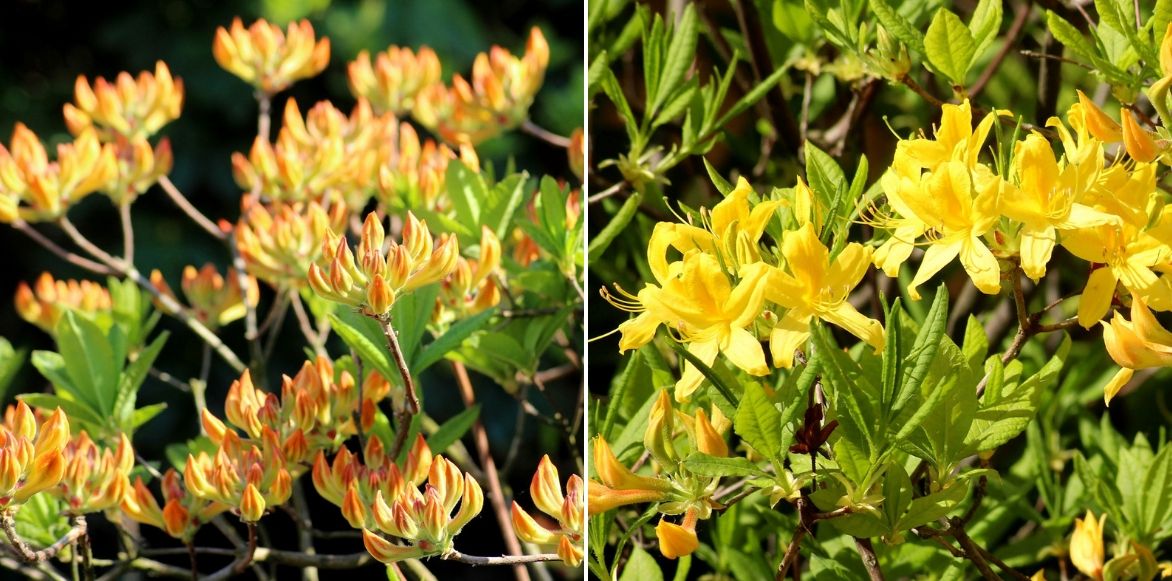
Azalea: in bud and in flower
Read also
Rhododendron: planting, growing and careMain species and varieties of garden azaleas

Azalea japonica Adonis
- Flowering time May
- Height at maturity 60 cm
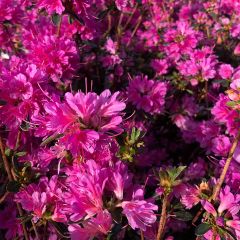
Rhododendron kaempferi Amoena - Japanese Azalea
- Flowering time April, May
- Height at maturity 80 cm
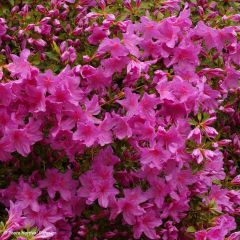
Azalea japonica Blue Danube
- Flowering time June
- Height at maturity 80 cm

Azalea japonica Kirin
- Flowering time April, May
- Height at maturity 1 m
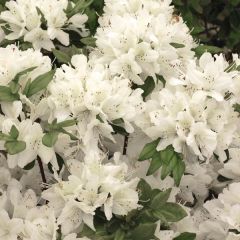
Azalea japonica Schneewittchen
- Flowering time June, July
- Height at maturity 60 cm
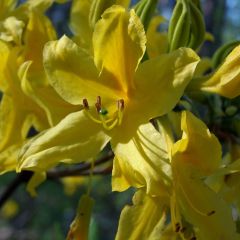
Rhododendron luteum
- Flowering time June, July
- Height at maturity 2,50 m
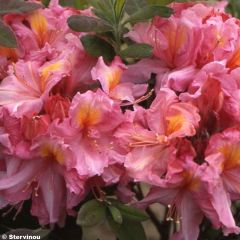
Rhododendron Berryrose - Western Azalea
- Flowering time May, June
- Height at maturity 1,20 m
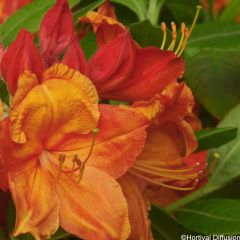
Azalea mollis Glowing Embers
- Flowering time June, July
- Height at maturity 1,50 m

Azalea Jolie Madame
- Flowering time May, June
- Height at maturity 1,50 m
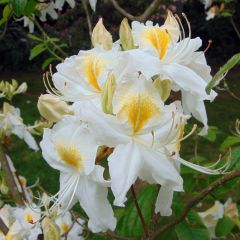
Azalea mollis Persil
- Flowering time June
- Height at maturity 1,25 m

Rhododendron macrosepalum Koromo-shikibu - Large-sepaled Azalea
- Flowering time April, May
- Height at maturity 60 cm
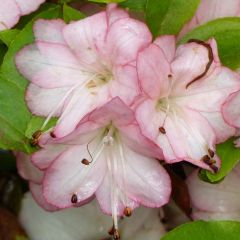
Rhododendron kaempferi Peggy Ann - Japanese Azalea
- Flowering time June
- Height at maturity 60 cm
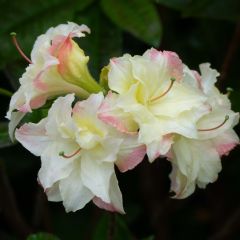
Azalea Cannons Double
- Flowering time May, June
- Height at maturity 1,20 m
Discover other Rhododendron and Azalea
View all →Available in 1 sizes
Available in 1 sizes
Available in 1 sizes
Available in 1 sizes
Available in 1 sizes
Available in 1 sizes
Available in 1 sizes
Available in 1 sizes
Available in 1 sizes
Available in 1 sizes
Planting azaleas
When to plant azaleas?
A bush grown in a container can be planted almost all year round, except during periods of frost or heatwave. It is nevertheless preferable to plant Azaleas in spring, around April, or in early autumn, in September–October. Planting while in flower also allows testing colour combinations in the garden before final installation.
Where to plant?
To succeed with Azalea culture, choose a bright but non-scorching situation and plant in non-calcareous soil.
Azaleas thrive in semi-shaded areas sheltered from wind, protected from the burning midday sun. Japanese Azaleas tolerate sun better in regions with temperate summers. In pots on terraces, they will do best in shade, or in a sunnier spot if you are diligent with watering.
A north or even west aspect is generally the best choice. Ideally, for the luckiest, plant under the light shade of large trees.
However avoid too dense shade, as good light encourages flowering. Also avoid placing a Japanese Azalea facing east, because morning sun can cause leaf and bud burn in winter after a sudden thaw.
If your soil is very calcareous, or you live in a very hot, dry summer region, choose a different type of plants, better adapted. Otherwise you would spend all your time watering for rather disappointing results. Azaleas are happiest in oceanic, temperate continental or mid-mountain climates.
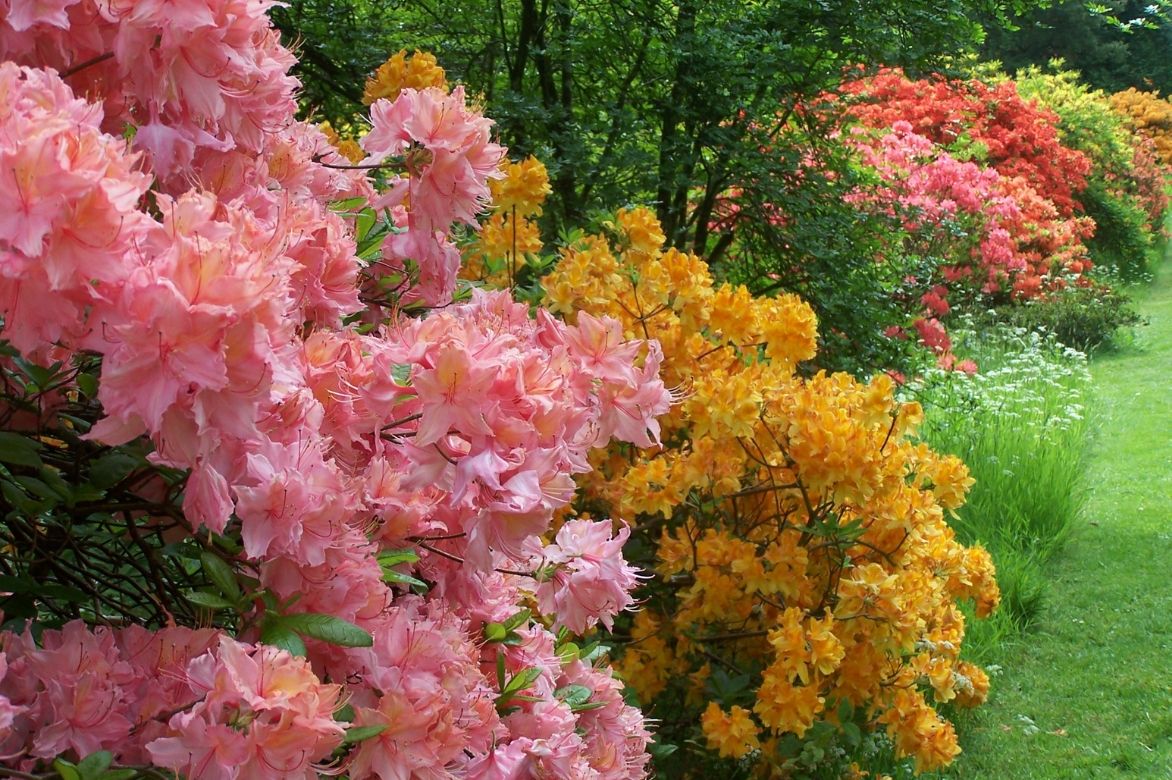
How to plant an azalea correctly?
Planting an Azalea is easier in acidic to neutral soil that is fairly porate and well aerated. If your soil is very heavy, clayey, follow the adapted advice below.
- Dig a hole about 40 to 60 cm deep, three times wider than the rootball.
- Mix in thirds non-calcareous soil, potting compost and ericaceous soil (based on acidic turf with high water retention). Add pumice to the mix and place some at the bottom of the hole so that water drains well. Indeed, Azaleas need soil with an acidic tendency to have healthy, green leaves. Acidity is measured by pH and their ideal for the genus Azalea lies between 5 and 6. They also dread lime, much less so if it is magnesium-based, such as dolomite. Finally, drainage is important, especially in winter so roots remain healthy and plants in excellent condition. In heavy, poorly draining clay soil, it is advisable to plant your bed on a small mound. This should be formed with the mix described above so that water drains away easily.
- To improve rooting, gently untangle the felt of small roots (rootlets) that may have formed around the plant if compact. Spray the edge of the rootball with a jet of water, then brush the rootlets to fluff them out and break the regular cylindrical shape of the rootball.
- Then soak the rootball for 10–15 minutes, then let it drain a little.
- Plant your azalea, preferably on a slightly raised bed so that water runs off well.
- Cover the rootball lightly with the prepared soil mix and tamp down gently.
- Create a slight depression with soil around the plant so you can water abundantly at its base without runoff.
- Water with about 10–15 litres of water, applied in two stages to finish consolidating the soil and to eliminate air pockets. It is essential that rootball and soil are in perfect contact. The hollow will then be covered with a mulch.
Read also
Plant young ericaceous plantsHow to grow an azalea in a pot?
Japanese azaleas are well suited to container cultivation on balconies and terraces.
My tips :
- Choose a shaded spot during the hottest hours of the day to limit heating and evaporation of water.
- Provide a draining layer at the base of the pot and a layer of mulch on the surface. Heathers planted at its base can serve the same purpose, while flowering through the long winter months. Spray its foliage in dry weather to prevent attacks by red spider mites.
Note: indoor or florist azaleas are different varieties and should be brought indoors for winter into a cool room at 5–15°C.
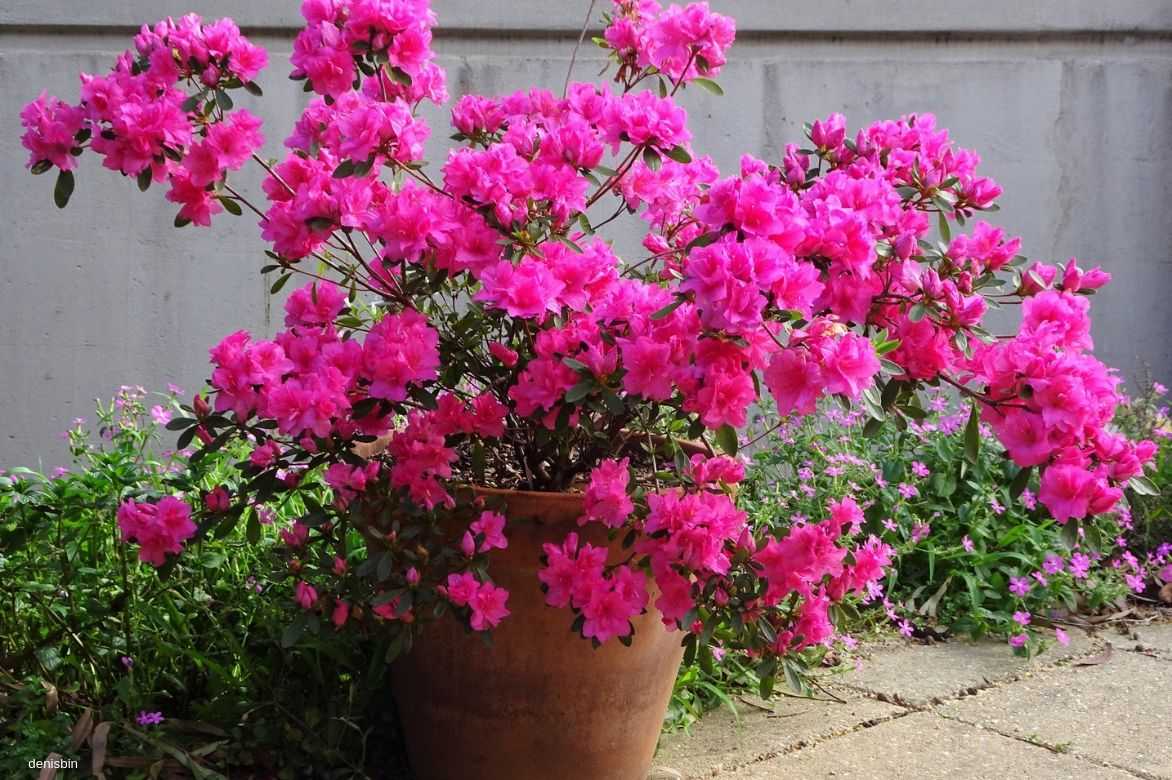
Potted azalea
Caring for azaleas
Maintaining Azaleas is fairly simple when they are well planted and in a location that suits them.
A good layer of mulch!
To reduce maintenance of your Azaleas, it is important to cover soil with a thick plant-based litter layer. This mulch is preferably made from pine bark, pine needles, or fern fronds. As it decomposes over time, top up mulch at the start of autumn, whenever necessary. Ideally maintain a layer about 8–15 cm thick, 15–20 cm if using fallen leaves. Mulch can be light during first years to encourage Azaleas to develop deep roots.
If soil is poor and plants are struggling, the most durable and beneficial solution is to mix into the mulch one-third well-rotted manure, compost or leaf mould. Otherwise, applying a fertiliser for ericaceous plants can also stimulate growth, but it will not boost soil life or long-term fertility.
→ to read on the subject: “Mulching: why? How?”
Watering
Azaleas need fairly constant moisture around roots. They should therefore be watered regularly in dry weather. Water needs are greater in spring, when growth resumes. Best practice is to allow soil surface to dry out between two waterings, encouraging Azaleas to send roots deeper.
Prefer watering with non-calcareous rainwater. Hard water may, over time, cause yellowing of leaves, a sign of chlorosis.
In summer, water in the evening if needed, also mist foliage to cool surroundings and increase air humidity.
A useful tip is to space out waterings in August–September; this encourages formation of flower buds for following spring.
In winter, remember to check whether Japanese Azaleas need water, especially after thaw. Their evergreen foliage needs water all year, transpires and can warm up in low winter sun.
Pruning Azaleas
Pruning Azaleas can be carried out after flowering.
Japanese Azaleas can be pruned into a ball, cushion shape or left natural. Shorten green shoots with shears, taking care not to cut into leafless wood.
Pruning of deciduous Azaleas is only done to rejuvenate an old plant or to encourage branching. Shorten a few overly long branches by cutting above a branching point. Remove some old branches at their base if younger ones can take over.
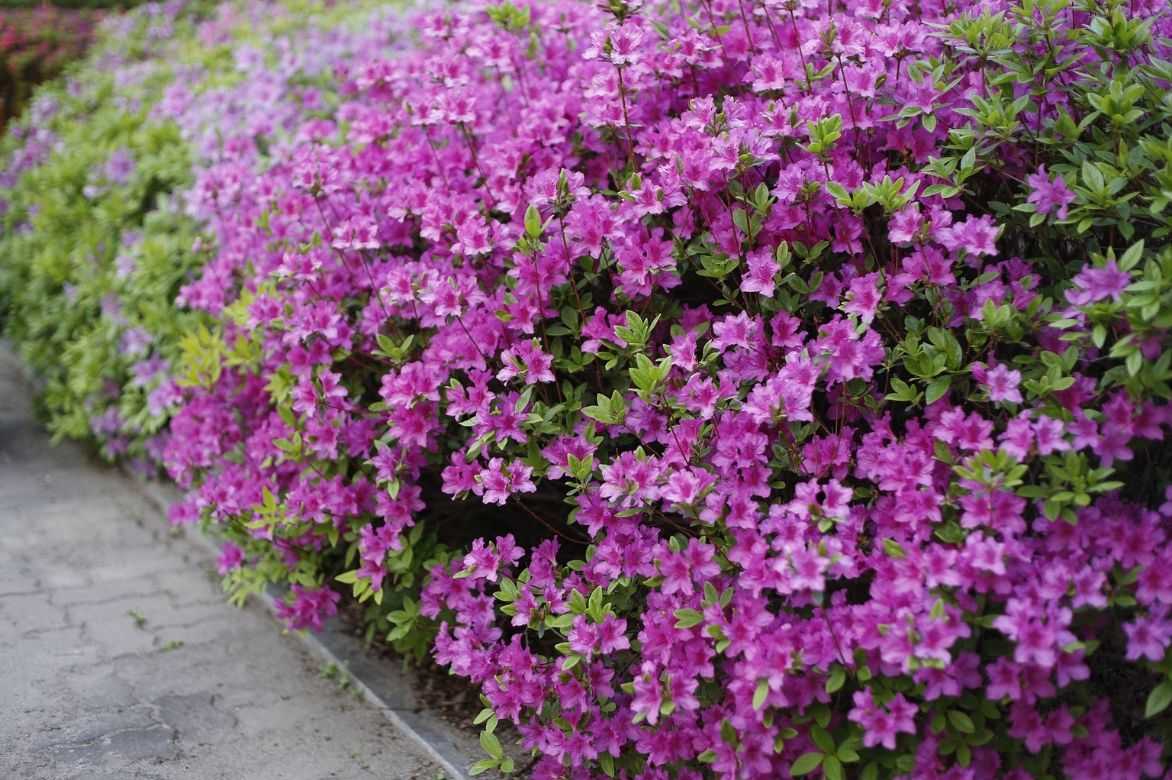
Potential diseases and pests
Your Azaleas will have very few health problems if grown in good conditions.
- If your Azalea’s leaves yellow around the veins, it suffers from chlorosis. This iron deficiency is caused by calcareous soil or irrigation water. Water the plant with a dilution of commercial anti-chlorosis product. Or prepare yourself a 10% dilution of nettle manure, or a 20% dilution of horsetail manure.
- Red spider mites can bite leaves of your azaleas located in a dry, warm spot. As prevention, regularly mist azalea foliage with water. As repellent, if infestation occurs, spray a garlic decoction onto foliage.
- Aphids may appear on shoots of your azaleas. Spray a 10% dilution of liquid black soap.
- Otiorhynchus weevils are beetles that notch leaf margins in a very characteristic way. Presence of ground beetles in garden helps regulate their population. Damage is more unsightly than dangerous, but a natural treatment using nematodes (Heterorhabditis) is possible. Diluted and watered into soil, it attacks buried larvae of these weevils and must be repeated until eradication, for several years if necessary.
- Azalea moth caterpillars sometimes devour their shoots. Treat only if very numerous, with organic insecticidal Bacillus thuringiensis (BT). Male moths can also be caught with a pheromone trap.
- Two major fungi able to kill garden azaleas are honey-coloured Armillaria and Phytophthora. Their appearance is due to root asphyxiation from excess water in winter and excessive soil compaction. Burn affected plants. Good drainage is therefore essential, with a bed of pumice at bottom of planting hole in heavy soil. Preparing a porous, well-aerated soil is also key.
- Powdery mildew sometimes whitens leaves of azaleas. At first there are white spots, then the fungus can cover entire leaf. As prevention, space plants sufficiently apart to encourage air circulation and avoid over-enriching soil with manure or nitrogenous fertilisers. Water at base of plant rather than on foliage. You can spray a horsetail or nettle manure onto foliage.
Propagation: layering, cutting
Propagation of azaleas is not among the easiest but can be attempted by the most daring, or those with a greenhouse or cold frame.
- Layering is by far the simplest method of propagation, although fairly slow. Use a low branch and bury it in June–July to make it root. Remove leaves from the part to be buried while keeping the leafy tip. Cut a thin strip of bark on the lower part of the stem. Dig a furrow about 7 cm deep and lay the branch down, keeping the incised lower part in contact with soil using a bent wire staple. Cover with soil while leaving the leafy tip above ground. It will take one and a half to two years before the layer can be separated from the parent plant. Replant in April–May or September–October.
- Cuttings can be planted in August–September, ideally under cover with good humidity. Gather early in morning thin lateral shoots of 9 to 12 cm from lower parts of plant. Leave top 4 leaves. Cut a thin vertical strip of bark and use plant hormone or willow water (maceration of willow shoots). Plant cuttings 5 cm deep, fairly close together, in turf mixed with a little sand. Ideally grow them under mist or enclosed under plastic, ventilating regularly and lightly, which is a delicate operation. Rooting can occur in about 4 months. Pot on in following spring, after removing terminal bud to encourage rooting and branching.
Uses and companion planting in the garden
Japanese azaleas can be placed on the edge of a terrace, at the front of a border, or planted in containers. Pruned into balls or cushions, they sit perfectly in the hummocks lining paths in Japanese gardens. Of montane origin, they are also comfortable in a cool rock garden, for example north-facing, accompanied by conifers and other rock-garden plants.

Japanese azaleas at Maulévrier Oriental Garden (49)
Deciduous azaleas, larger and more erect, are placed at the back of a bed.
Some planting ideas
Ericaceous plants are ideal partners for azaleas. You can therefore plant with them Japanese pieris, Enkianthus, Japanese maples, Magnolias, Mahonia, Aucuba, Camellias, mountain laurels (Kalmia), Sarcococca, etc. And why not plant heathers and callunas at their feet, thereby reducing maintenance and keeping soil cooler for longer.
To create a natural look, ferns are very useful. See Alexandra’s article: 9 easy ideas for combining ferns successfully. Grasses and related plants fulfil the same role. Think of Carex, Hakonechloa, Luzula, Ophiopogon.
Perennial plants complete the picture perfectly. For example Ajuga, columbines (Aquilegia), anemones, Brunnera, bleeding-heart (Dicentra), comfrey, Corydalis, Hostas, Euphorbia griffithii ‘Dixter’ (polychrome) or Euphorbia amygdaloides ‘Purpurea’, Heucheras or Tiarellas, Hellebores, pulmonarias (lungwort), Tricyrtis or toad lily.
Among bulbs, you can plant without hesitation: Camassia, Spanish bluebell (Hyacinthoides hispanica), narcissus, Fritillaria.
And finally some annuals to sow such as forget-me-not (Myosotis).
For example, imagine a Rhododendron luteum and an Azalea ‘Schneewittchen’ surrounded by a carpet of Spanish bluebells!
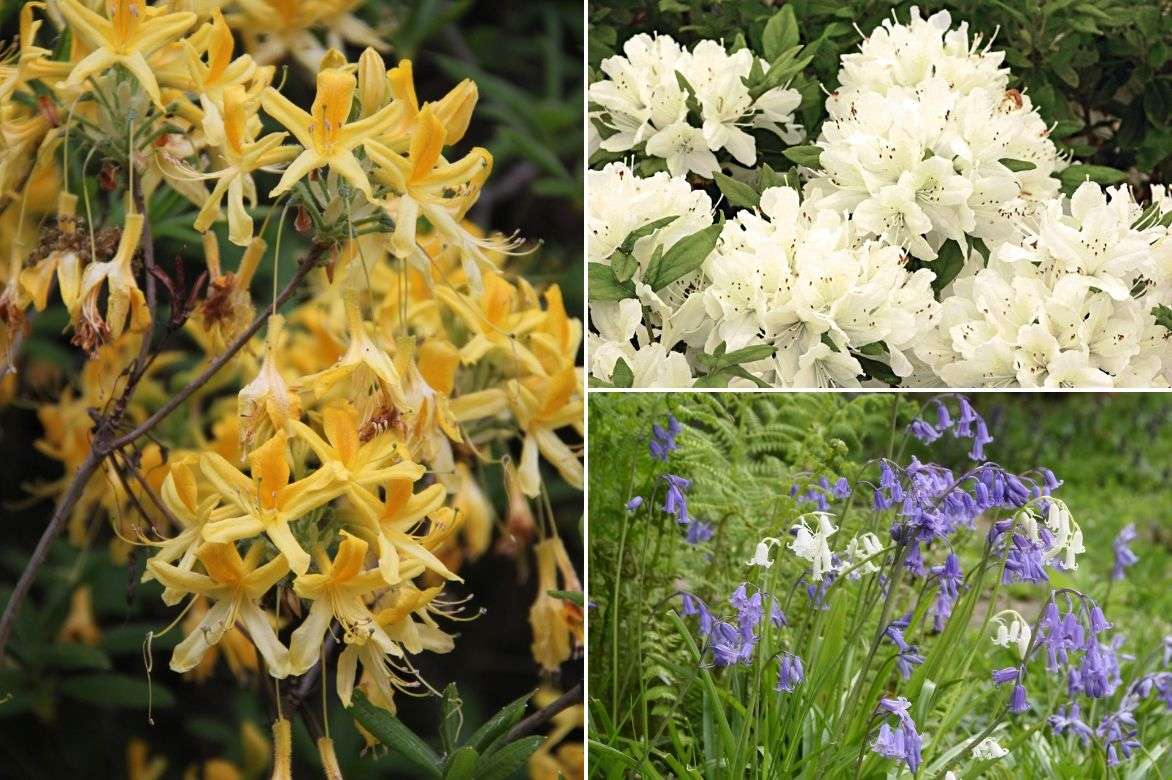
An example of a combination: Rhododendron luteum, Azalea ‘Schneewittchen’ and Hyacinthoides hispanica
Did you know?
The origin of these plants’ name has had several twists, sometimes called Azalea, sometimes Rhododendron, as botanists disputed. In antiquity, it was the oleander that was called Rhododendron (Tree of roses in Latin). It was the Italian Andreas Caesalpino who first attempted, in 1583, to include these ericaceous plants in that genus.
Father of modern botany, Carl Von Linne, included nine of these plants in his famous foundational work, Species Plantarum, in 1753. He separated five plants that he considered of different character, naming them Azalea. Azalea is in Ancient Greek the feminine of Azaleos, which means “dry”. This refers to their relatively greater resistance to dry periods compared with Rhododendron.
Azaleas were reintegrated into the genus Rhododendron by botanists, following demonstrations by English botanist Richard Salisbury in 1805 and 1808.
But let us not forget what French writer and horticulturist Alphonse Karr said: “Botany is the art of drying plants between sheets of blotting paper and insulting them in Greek and Latin.” Far from these botanical quarrels, gardeners and nurserymen continue to distinguish this distinct group by calling it Azalea, even if this means blaspheming the sacred botanical scriptures!
Find out more
- Find your favourite among our wide range of azaleas!
- Find companions for your azaleas among the ericaceous plants.
- Visit the national collection of azaleas and rhododendrons at the Domaine de Trevarez
- Discover our care sheet: To grow an Azalea in a pot
- Chinese azaleas: the best varieties
- Japanese azaleas: the best varieties, 10 Japanese azaleas with pink flowers
- Choose the right Azalea
- 10 white azaleas to brighten the garden
- Find our article on diseases and parasitic pests of Japanese azalea
Frequently asked questions
-
If your azalea's leaves are turning yellow, follow these checks and remedies to diagnose and fix the problem.Quick diagnosis — common causes- Overwatering / poor drainage: Waterlogged roots cause yellowing and wilting. - Underwatering / drought stress: Leaves yellow then brown and drop. - Iron chlorosis (interveinal yellowing with green veins): usually caused by alkaline soil. - Nutrient deficiency (nitrogen, magnesium): general yellowing or yellowing of older leaves. - Too much sun / heat stress: scorched or bleached yellowing, especially on south- or west-facing sites. - Pests (lace bugs, spider mites): stippling, fine webbing, or discoloured patches on leaves. - Root problems / root rot: brown, mushy roots when plant is lifted. - Fungal or viral disease: patchy yellowing, spots, premature leaf drop.Step-by-step checks1. Inspect soil moisture: push finger 5–10 cm into soil. If very wet, suspect overwatering; if bone dry, thirsty. 2. Check drainage: is plant in free-draining ericaceous compost or heavy, compacted soil? 3. Examine leaves (upper and underside) for pests, stippling, or webbing. 4. Look at roots (if possible): gently lift plant from pot or dig small section to view root colour/texture. 5. Test soil pH with a kit: azaleas prefer acidic soil pH 4.5–6.0. Alkaline soil causes iron deficiency. 6. Note location: full sun, afternoon sun or shade? Recent temperature extremes or transplanting?Remedies- Overwatering/poor drainage: reduce watering, improve drainage, amend soil with grit or organic matter, consider lifting and replanting in free-draining ericaceous compost or potting mix. - Underwatering: water deeply and regularly until established; mulch to conserve moisture. - Iron chlorosis (yellow leaves with green veins): apply chelated iron (follow label), or use a foliar iron spray for a quicker fix. Long term: acidify soil with ericaceous compost, mulches of pine needles or spent hops, or elemental sulphur (slow-acting). - Nutrient deficiency: apply an ericaceous fertiliser formulated for acid-loving plants, following label rates. Avoid high-nitrogen feeds that can stress roots. - Sun/heat stress: move to a more sheltered or partially shaded spot if possible, or provide afternoon shade. - Pests: wash leaves with strong water spray, use insecticidal soap or horticultural oil for spider mites; for lace bug severe infestations, consider registered insecticidal treatment or consult local garden centre. - Root rot: if roots are brown and mushy, trim rotten roots, repot in fresh ericaceous compost with good drainage, and reduce watering. Severely affected plants may not recover. - Diseases: remove and dispose of affected leaves, improve air circulation, avoid overhead watering, and use fungicide if recommended for the specific disease.Prevention tips- Plant azaleas in ericaceous (acid) compost or soil, or use ericaceous potting mix for containers. - Keep soil moist but not waterlogged; mulch to retain moisture and regulate temperature. - Feed annually in spring with an ericaceous fertiliser. - Avoid lime or alkaline compost near azaleas. - Inspect regularly for pests and treat early.If unsure, take a clear photo of affected leaves (both upper surface and underside) and soil around roots, plus a note of watering routine and planting situation, and show it to your local garden centre or send to a local extension/advice service for a more precise diagnosis.
If the veins of the leaves remain greener, this is chlorosis caused by soil or irrigation water that is too calcareous. Water the plant with rainwater or acidify it with a little lemon juice or white vinegar. Apply a soluble iron product, available commercially as an anti-chlorosis treatment. If foliage of your azalea yellows uniformly, it may be a nitrogen deficiency. You should then cover the soil with a layer of about 6 cm of good compost or well-rotted manure.
-
My azalea is too close to my photinia, which has grown too large. Can I move it?
Yes, azaleas transplant easily, preferably in October or in late winter. Make sure to dig around the plant with a spade, slightly beyond the branches, to best preserve the root ball and its roots.
- Subscribe!
- Contents
































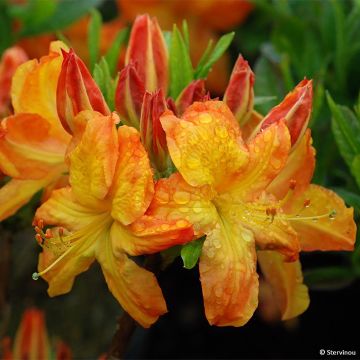
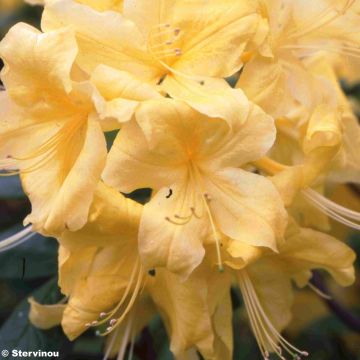
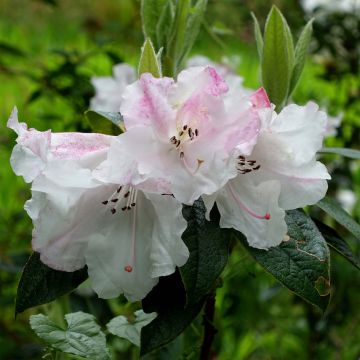
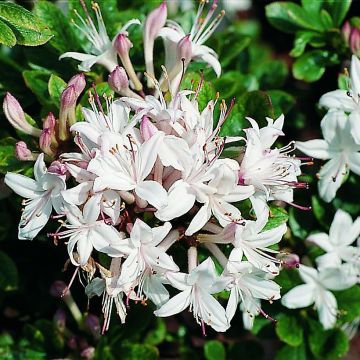
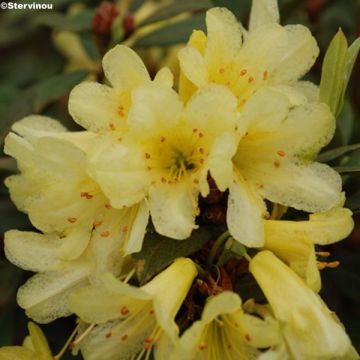
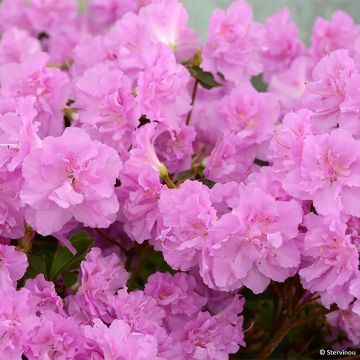
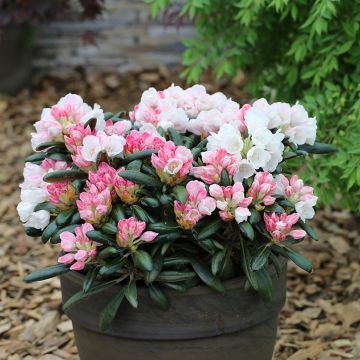
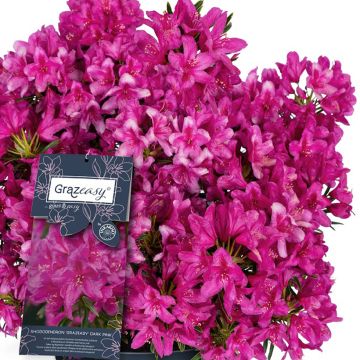

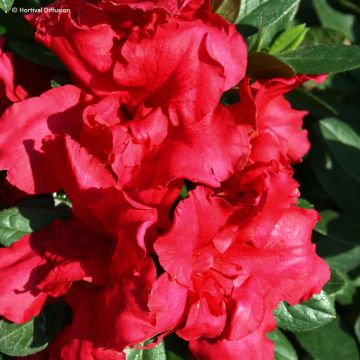
Comments